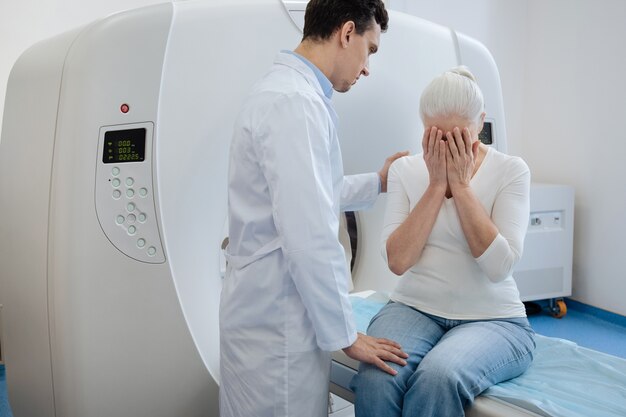Understanding the Role of MRI in Detecting Dementia
In the realm of medical diagnostics, the question often arises: Can an MRI detect dementia? This query doesn't just spring from the depths of scientific curiosity; it emerges from the pressing need to understand, diagnose, and manage a condition that affects millions worldwide. Dementia, with its intricate tapestry of symptoms, demands a multi-faceted approach to diagnosis. While an MRI is a potent tool in the arsenal of diagnostic methods, its role is as nuanced as the condition itself.
What is Dementia?
To comprehend how an MRI might play a part in dementia detection, it's crucial to first understand what dementia is. Dementia is not a single illness but a syndromic collection of symptoms that can be caused by various diseases affecting the brain. Characteristically, it involves a decline in memory, reasoning, and other thinking skills severe enough to impair daily life.
Types of Dementia
- Alzheimer’s Disease: The most common cause of dementia, accounting for 60-80% of cases. It involves progressive brain cell death.
- Vascular Dementia: Caused by blood flow problems affecting the brain, often after a stroke.
- Lewy Body Dementia: Associated with abnormal protein structures forming in the brain.
- Frontotemporal Disorders: Affecting the frontal and temporal lobes of the brain, impacting personality and behavior.
Understanding the type of dementia a person has is vital for effective management and treatment. This is where imaging techniques, like MRI, come into play.
How Does an MRI Work?
Magnetic Resonance Imaging (MRI) is a non-invasive imaging technique used to create detailed photographs of the organs and tissues within the body. It relies on strong magnetic fields and radio waves to generate images of the brain in great detail.
Advantages of MRI
- Non-Invasive: No need for surgery or ionizing radiation.
- High Resolution: Offers clear and more detailed images of the brain's structure.
- Versatility: Can detect a range of brain anomalies, from tumors to vascular conditions.
The Role of MRI in Detecting Dementia
While MRIs aren't used for the definitive diagnosis of dementia, they do play a crucial role in the diagnostic process. Here's how:
Identifying Brain Atrophy
One of the hallmark signs of certain dementias, especially Alzheimer's, is brain atrophy. This is the gradual loss of brain cells, which results in a reduction in brain size. An MRI can vividly show this reduction, particularly in specific areas like the hippocampus, which is critical for memory and learning.
Detecting Vascular Changes
In cases of vascular dementia, an MRI can detect changes in blood vessels or identify areas of the brain affected by strokes, inferring possible causes of dementia symptoms.
Assessing Structural Abnormalities
Certain forms of dementia, like frontotemporal dementia, may present with distinct changes in specific brain regions. MRI scans help in identifying these changes, aiding in the precise classification of dementia types.
MRI vs. Other Diagnostic Tools
While MRI is invaluable, it is part of a broader diagnostic toolkit. Let's explore how it stacks up against other methods:
CT Scans
- Similarities: Both MRI and CT scans offer detailed images of the brain.
- Differences: CT scans use X-rays and are less detailed than MRIs. MRIs are favored for repeated scans since they do not involve radiation.
PET Scans
- Functionality: PET scans offer insights into how the brain works (metabolism and activity) rather than its structure.
- Complementary Use: Often used alongside MRI to provide a comprehensive view of the brain.
Limitations of MRI in Dementia Detection
Sensitivity and Specificity
While MRI can detect physical changes in the brain, these changes don't necessarily confirm dementia. Not all individuals with brain changes exhibited in an MRI have dementia, nor does a clear MRI rule it out.
Cost and Accessibility
MRIs are more expensive and less accessible compared to other diagnostic methods, potentially limiting their widespread use.
Preparing for an MRI
If an MRI is part of your diagnostic journey, being prepared can ease the process. Here are some tips:
- Inform the Technician: About any implants or metal in your body.
- Wear Comfortable Clothing: Preferably without metal fasteners or buttons.
- Discuss Claustrophobia: If you are prone to anxiety in small spaces, discuss this with your healthcare provider.
The Path After MRI: Next Steps for Patients
Understanding what comes after an MRI is equally crucial. Here are steps to consider:
Consult with Healthcare Providers
Discuss the MRI results in detail with your neurologist or primary care physician. Understanding the implications of findings is crucial for peace of mind and planning.
Explore Comprehensive Evaluations
MRI is usually part of a wider diagnostic evaluation. Consider cognitive testing, lab tests, and neuropsychological assessments.
Consider Psychosocial Support
Should a diagnosis be made, support from social workers, therapists, and support groups can make the journey more manageable.
Living with Dementia: Practical Steps
Navigating life with a dementia diagnosis involves various adjustments. Here are some practical steps:
- Create a Routine: Consistent daily habits can help minimize confusion.
- Simplify Tasks: Use tools and modifications to ease everyday activities.
- Engage in Physical Activity: Regular exercise can improve brain function and overall health.
- Professional Care: Consider professional help from occupational therapists or in-home care for additional support.
Emphasizing Understanding and Empathy
In understanding the role of MRI in detecting dementia, it's vital to remember that diagnosing dementia is a deeply personal journey that involves not only medical science but also empathy and understanding. Being informed about the advantages and limitations of MRIs in this context can empower you to make informed decisions.
Summary: MRI and Dementia Diagnosis
- MRI's Role: Essential for identifying brain changes.
- Comparisons: More detailed than CT, complementary to PET.
- Limitations: Not definitive, cost implications.
- Practical Tips: Prepare well for scans, follow up diligently.
- Support Pathways: Consultation, comprehensive evaluations, psychosocial support.
🌟 Key Takeaway: MRI is a valuable tool but works best as part of a broader, empathetic approach to diagnosing and managing dementia.
